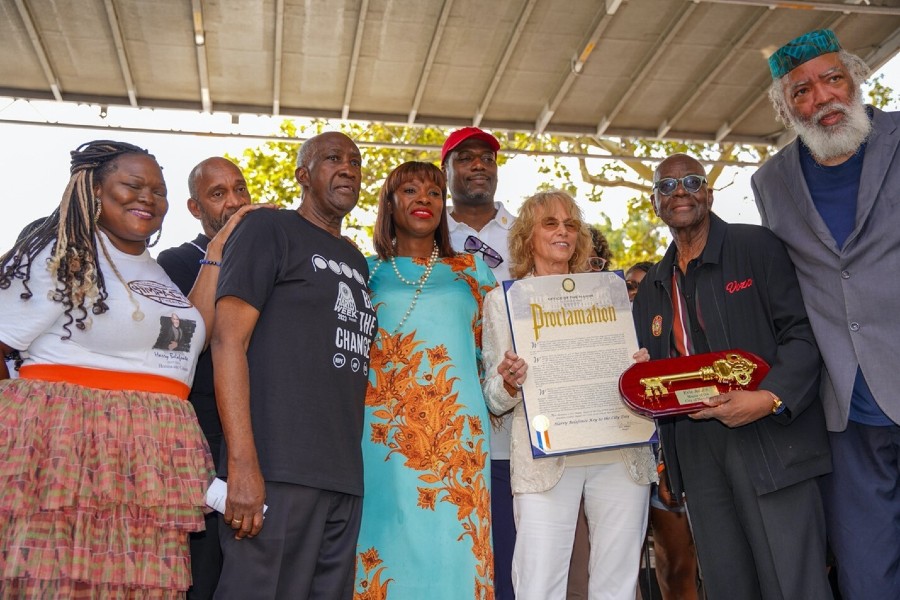
In the summer of 1974, Harlem stood at a crossroads.
Once the vibrant epicenter of Black culture and creativity, the neighborhood had fallen victim to decades of disinvestment and neglect.
Empty storefronts and crumbling buildings lined the streets, silent witnesses to the mass exodus known as “urban flight” that had drained Harlem of its more affluent and educated residents.
Yet, from this nadir arose a vision that would reshape Harlem’s future. Percy Sutton, then Manhattan Borough President and New York City’s highest-ranking Black elected official, recognized that Harlem needed more than just economic investment – it needed a revival of spirit.
The Birth of Harlem Day
Sutton’s brainchild, initially known as “Harlem Day,” was far more than a typical neighborhood festival. It was a clarion call to Harlem’s past glory and future potential.
Sutton assembled a coalition of Harlem’s finest – religious leaders, politicians, civic organizers, and artistic luminaries including Tito Puente, Max Roach, Maya Angelou, James Baldwin, Harry Belafonte, and Sidney Poitier.
On that first Harlem Day, the neighborhood pulsed with renewed energy. Radio legends Hal Jackson and Frankie Crocker orchestrated a concert at the Harlem State Office Building plaza, while the incomparable Ossie Davis presided over a ribbon-cutting ceremony at 138th Street and 7th Avenue.
This ceremony not only marked the start of what Davis dubbed the “Second Harlem Renaissance” but also saw 7th Avenue rechristened as Adam Clayton Powell Jr. Boulevard – the first New York City street named after a person of color.
From Day to Week: The Evolution of a Movement
The success of Harlem Day reverberated far beyond the neighborhood’s boundaries. Lloyd Williams, one of the event’s co-founders and current president of the Greater Harlem Chamber of Commerce, recalls Percy Sutton’s words in the aftermath: “It meant so much to the other cities that were being deserted in Detroit and Baltimore, Washington and Chicago, that they asked if we would do it again on an annual basis”.
- LISC CEO Michael T. Pugh Recognized Among 2024 Worthy 100 Leaders
- NY Lawmakers Celebrate Historic MENA Data Recognition Bill Signed By Hochul
- Sponsored Love: Leadership Skills Training Courses: Invest In Your Future Today
- Senator Hoylman-Sigal Calls On Independent Schools To Adopt NYC Public School Calendar
- Mayor Adams Celebrates 65 Million NYC Visitors In 2024, Second-Highest Ever
And so, Harlem Day grew. It expanded to Harlem Weekend, and eventually to Harlem Week – a celebration that, in pre-pandemic years, stretched to a full month of programming. As Williams quips, “Only in Harlem could a week be more than seven days”.
Harlem Week 2024: A Golden Jubilee
This year, Harlem Week marked its 50th anniversary with an 18-day extravaganza that truly encapsulated the neighborhood’s journey from crisis to renaissance. The celebration featured a diverse array of events, from a headline performance by hip-hop artist Fabolous to a touching tribute to the late Harry Belafonte. Broadway performances shared billing with concerts showcasing the jazz, reggae, R&B, and gospel traditions that have long been nurtured in Harlem’s creative soil.
But true to its roots as more than just a festival, Harlem Week 2024 also focused on community empowerment. Financial literacy workshops and health screenings were offered at the Harlem Health Village, while the Children’s Festival ensured that every young attendee left with a back-to-school backpack.
A Living Legacy
As Rev. Al Sharpton, whose National Action Network is headquartered in Harlem, puts it, Harlem Week stands as “the constant line through the last 50 years of America’s most historic Black neighborhood”. It’s a living tribute to Harlem’s pantheon of greats – from W.E.B. Du Bois and Langston Hughes to Augusta Savage and Aaron Douglas – and a celebration of landmarks like the Apollo Theater and the Schomburg Center for Research in Black Culture.
Fifty years on, Harlem Week remains a powerful testament to the neighborhood’s resilience, creativity, and enduring cultural significance. It’s a reminder that even in the darkest times, the spirit of Harlem – and the vision of leaders like Percy Sutton – can illuminate a path forward. As we look to the future, Harlem Week continues to inspire, educate, and unite, proving that the dream of Harlem’s renaissance is not just alive, but thriving.
Photo credit: Harlem Week 2024 by Sietu Oronde.
Become a Harlem Insider!
By submitting this form, you are consenting to receive marketing emails from: . You can revoke your consent to receive emails at any time by using the SafeUnsubscribe® link, found at the bottom of every email. Emails are serviced by Constant Contact








